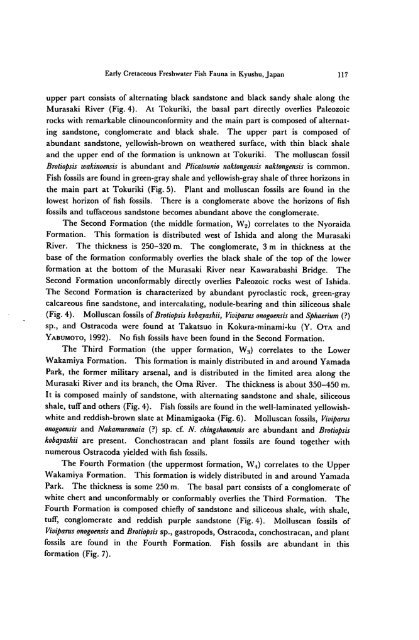Early Cretaceous Freshwater Fish Fauna in Kyushu, Japan
Early Cretaceous Freshwater Fish Fauna in Kyushu, Japan
Early Cretaceous Freshwater Fish Fauna in Kyushu, Japan
You also want an ePaper? Increase the reach of your titles
YUMPU automatically turns print PDFs into web optimized ePapers that Google loves.
<strong>Early</strong> <strong>Cretaceous</strong> <strong>Freshwater</strong> <strong>Fish</strong> <strong>Fauna</strong> <strong>in</strong> <strong>Kyushu</strong>,<strong>Japan</strong> 117<br />
upper part consists of alternat<strong>in</strong>g black sandstone and black sandy shale along the<br />
Murasaki River (Fig. 4). At Tokuriki, the basal part directly overlies Paleozoic<br />
rocks with remarkable cl<strong>in</strong>ounconformity and the ma<strong>in</strong> part is composed of alternat<br />
<strong>in</strong>g sandstone, conglomerate and black shale. The upper part is composed of<br />
abundant sandstone, yellowish-brown on weathered surface, with th<strong>in</strong> black shale<br />
and the upper end of the formation is unknown at Tokuriki. The molluscan fossil<br />
Brotiopsis wak<strong>in</strong>oensis is abundant and Plicatounio naklongensis naktongensis is common.<br />
<strong>Fish</strong> fossils are found <strong>in</strong> green-gray shale and yellowish-gray shale of three horizons <strong>in</strong><br />
the ma<strong>in</strong> part at Tokuriki (Fig. 5). Plant and molluscan fossils are found <strong>in</strong> the<br />
lowest horizon of fish fossils. There is a conglomerate above the horizons of fish<br />
fossils and tuffaceous sandstone becomes abundant above the conglomerate.<br />
The Second Formation (the middle formation, W2) correlates to the Nyoraida<br />
Formation. This formation is distributed west of Ishida and along the Murasaki<br />
River. The thickness is 250-320 m. The conglomerate, 3 m <strong>in</strong> thickness at the<br />
base of the formation conformably overlies the black shale of the top of the lower<br />
formation at the bottom of the Murasaki River near Kawarabashi Bridge. The<br />
Second Formation unconformably directly overlies Paleozoic rocks west of Ishida.<br />
The Second Formation is characterized by abundant pyroclastic rock, green-gray<br />
calcareous f<strong>in</strong>e sandstone, and <strong>in</strong>tercalat<strong>in</strong>g, nodule-bear<strong>in</strong>g and th<strong>in</strong> siliceous shale<br />
(Fig.4). Molluscan fossils of Brotiopsis kobayashii, Viviparus onogoensis and Sphaerium (?)<br />
sp., and Ostracoda were found at Takatsuo <strong>in</strong> Kokura-m<strong>in</strong>ami-ku (Y. Ota and<br />
Yabumoto, 1992). No fish fossils have been found <strong>in</strong> the Second Formation.<br />
The Third Formation (the upper formation, W3) correlates to the Lower<br />
Wakamiya Formation. This formation is ma<strong>in</strong>ly distributed <strong>in</strong> and around Yamada<br />
Park, the former military arsenal, and is distributed <strong>in</strong> the limited area along the<br />
Murasaki River and its branch, the Oma River. The thickness is about 350-450 m.<br />
It is composed ma<strong>in</strong>ly of sandstone, with alternat<strong>in</strong>g sandstone and shale, siliceous<br />
shale, tuffand others (Fig.4). <strong>Fish</strong> fossils are found <strong>in</strong> the well-lam<strong>in</strong>ated yellowishwhite<br />
and reddish-brown slate at M<strong>in</strong>amigaoka (Fig. 6). Molluscan fossils, Viviparus<br />
onogoensis and Nakamuranaia (?) sp. cf. N. ch<strong>in</strong>gshanensis are abundant and Brotiopsis<br />
kobayashii are present. Conchostracan and plant fossils are found together with<br />
numerous Ostracoda yielded with fish fossils.<br />
The Fourth Formation (the uppermost formation, W4) correlates to the Upper<br />
Wakamiya Formation. This formation is widely distributed <strong>in</strong> and around Yamada<br />
Park. The thickness is some 250 m. The basal part consists of a conglomerate of<br />
white chert and unconformably or conformably overlies the Third Formation. The<br />
Fourth Formation is composed chiefly of sandstone and siliceous shale, with shale,<br />
tuff, conglomerate and reddish purple sandstone (Fig.4). Molluscan fossils of<br />
Viviparus onogoensis and Brotiopsis sp., gastropods, Ostracoda, conchostracan, and plant<br />
fossils are found <strong>in</strong> the Fourth Formation. <strong>Fish</strong> fossils are abundant <strong>in</strong> this<br />
formation (Fig. 7).

















